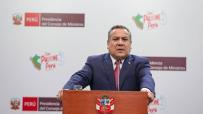
The tributaries that will form the Napo River in the western Ecuadorian Amazon are born at the mythical Llanganates National Park in the Ecuadorian Andes, where legend has it that the treasure of the Inca Atahualpa was hidden. The communities around the river make their living mainly from agriculture, although some indigenous people and settlers have been extracting gold in an artisanal way for years. But everything has changed drastically in the last few years: dozens of illegal machines and dredgers have taken over the basin.
"We have taken care of the river; the illegal miners have come to destroy it," says Elsa Cerda, leader of the Serena community of the Kichwa indigenous people. The community is located on the banks of the Jatunyaku (meaning “Big River”), which is a tributary of the Napo, six hours from Quito. There are 150 mining concessions in this area, but several of them have been taken over by illegal mining.
This type of mining in the Napo uses large crawler excavators to remove tons of soil and extract illegal gold on a large scale. This activity is mostly found in the cantons of Tena and Carlos Julio Arosemena, around the Napo River and its tributaries, where most of the inhabitants are Kichwa and Shuar indigenous peoples and settlers.
The devastation in this basin repeats itself in other areas, such as in the Camilo Ponce Enriquez canton, in the province of Azuay, where drug trafficking controls extraction. Illegally extracted gold finances criminal activities and is sold in jewelry stores due to weak oversight of supply chains and severe inconsistencies in official information on exported gold.
The OAS report on illegal gold mentions that in recent years illegal mining groups have also strengthened their ties with organized crime, with a growing presence of miners from Brazil, Venezuela and Peru.
A seven-month investigation carried out by OjoPúblico and Vistazo's Transboundary Network –part of the "The Dirty Gold Routes" series in five Amazonian countries and in which 18 journalists participated– reveals the severe inconsistencies in Ecuador's gold production data. The report exposes that the gap between what was officially declared to be produced and what was finally exported, between 2014 and 2023, was 20.52 tons. This amount of gold reached international markets without having a known origin.

SEIZURE. In May 2022, during the arrest of drug trafficker Leandro Norero, 42 gold bars were found.
Photo: Office of the Attorney General of Ecuador (The photograph has been rescaled with the Open Source program Upscayl)
The investigation identifies that in most cases the illegally extracted gold from the Amazon and other prohibited areas is transported to beneficiation plants –where the ore is refined –located in the provinces of El Oro and Azuay. The ore is finally washed and incorporated into the system with concession papers.
Intermediaries falsify invoices from supposed artisanal miners to justify the origin of the illegal gold, confirms a report by the Department against Transnational Organized Crime of the Organization of American States.
Luis Bonilla, former director of the Agency for Regulation and Control of Energy and Non-Renewable Natural Resources –the entity that oversees gold in Ecuador– admitted that one of the limitations to avoid laundering of gold mining is that the operators "take the mineralized material (rocks and mud) to these plants where it’s impossible to determine how much of that raw material is turned into gold".
Between 2014 and 2016, more than 80% of the gold exported from Ecuador was destined for the United States. In fact, in 2016 the Prosecutor's Office of this country initiated investigations for anomalies in the purchase chain of two companies concentrating half of the exports: Spartan and Clearprocess. At that time, the Attorney General reported that seven people, including shareholders of both companies, remained in custody.
After 2015, gold exports from Ecuador fell and in 2019 they began to increase. The United States was no longer the main buyer. The United Arab Emirates and India became the new destinations.
The inconsistency of government figures
Analysis by OjoPúblico and Vistazo's Cross-Border Network of a database of gold exports from five Amazonian countries –Colombia, Ecuador, Peru, Bolivia, and Brazil, constructed with information from Customs– reveals serious inconsistencies in the official information on gold production in Ecuador.
The different sources of information handle dissimilar data on production. The Central Bank of Ecuador indicates, for example, that 17.7 tons were exported in 2022; and the figure provided by the Energy Regulation Agency establishes 14.99 tons. However, this journalistic investigation found that 19 tons were exported.
The Central Bank itself mentions, about its data presented between 2019 and 2021, that at that time it could only make estimates and not more precise figures of gold production because the Regulatory Agency was going through "a critical situation of limited personnel" for the control of mines and processing plants.

CRITICAL. Illegal mining in the tributaries and the Napo River has been on the rise for the past five years, and the authorities have not been able to halt its advance.
Photo: Courtesy of Napo Ama La Vida collective.
Former energy minister Xavier Vera said two years ago that illegal mining in Ecuador moved between US$800 million and US$1 billion each year. That year, the country exported 19 tons of gold.
Last year, when asked about these figures, the head of the Mining Regulation Agency from the previous government, Luis Bonilla, acknowledged his agency did not have estimates of the real extent of the illegal gold production, but expressed his concerns about the difference between the declared production and the actual amount exported.
Regarding the differences between the gold declared and the gold produced, Luis Bonilla said for this investigation –when he was still in office– that his agency had "raised the alarm" about at least three exporting companies that in 2023 unusually increased their shipments to the United Arab Emirates and India.
He did not specify which companies he was referring to, but he did confirm to OjoPúblico and Vistazo that information has been requested and sent to the control agencies for the respective investigations. What he did detail is that these are companies that increased their exports exponentially from one year to another, and even mentioned that one of them "did not export anything in previous years, and appeared in 2023 as one of the main ones".
Vistazo's analysis of a gold exports database from five Amazonian countries –put together by OjoPúblico with information from Customs– reveals that the top ten companies and individuals that exported the majority of gold in 2023 include large and small companies, as well as some individuals.
Last year, 30% of the gold exported belonged to the Canadian company Aurelian, which oversees the first large-scale gold project in Ecuador: Fruta del Norte. In this case, its mineral shipments go to Switzerland and are audited by the Regulatory Agency. This large mining company has occupied the first places in exports in recent years.
But new players have emerged in 2023, including Rockgolden, Rocadora, David Bermeo, Orocomin Francisco Proaño, Winston Orellana, Martha Castro, Exycominsur and Manuel Quituisaca.
Illegal gold, organized crime and drug trafficking
In the midst of an internal security crisis, illegal gold mining in Ecuador has spread throughout the Napo basin in recent years. The Jatunyaku River, known for its favorable flow for rafting, has been filled with pools of fuel -contaminated water, oil and other chemicals used by the huge backhoes on the banks.
At the confluence of the Jatunyaku and Anzu rivers –which form the Napo River–, is the Yutzupino area, another illegal mining site since late 2021. Illegal mining has now reached the province of Orellana, in the Punino area.
Drone overflight images taken for this investigation confirm the catastrophe. A judiciary officer –who asked to protect his identity for security reasons– confirmed that illegal miners have managed to penetrate the protected area of Llanganates National Park.
DAMAGE. Illegal mining camps are set up along the Napo River basin and its tributaries with tracked excavators that move from one point to another.
Photo: Segundo Espín
In this territory, as well as in southern Ecuador, judicial and police sources in the area confirm that organized crime linked to drug trafficking is also behind the illegal gold business, due to the ease with which gold can be used to launder assets.
All versions concur in that Los Lobos –one of the most violent criminal gangs linked to drug trafficking–provides security and arms to illegal miners in the Napo basin. This gang operates another 20 mines in the southern canton of Camilo Ponce Enríquez.
The links of this activity with drug trafficking were exposed when the details of the Metastasis case were revealed. This investigation by the Ecuadorian Attorney General's Office revealed the links of drug trafficker Leandro Norero with judges, politicians, police, military, and businessmen in the country.
One of the conversations in the prosecutor's file –and to which OjoPúblico and Vistazo had access– shows how Norero intended to launder more than 40 gold bars that were found in his possession during the police intervention. Norero was a financier of the criminal gang Los Lobos.
"I am sending you the contract of the person who is willing to commit suicide for you and take charge of that gold," his lawyer warns him in one of the chats, alluding to the fact that the illegal gold was going to be laundered by means of using that businessman’s the legal mining exploitation documents. "You have records of having extracted for the last six years 24 tons of raw material containing gold fragments," reads the chat.

GOLD LAUNDERING. The contents of Norero's cell phone, decrypted in the context of the money laundering investigation for the Metastasis case.
Picture: Vistazo
In a Security Council held in the province of Napo, led by the governor, Carmen Masabanda, and with the participation of representatives of the Police, the Armed Forces, the Attorney General's Office and other institutions, the impact of the state of emergency imposed in the area to confront illegal mining was analyzed.
In that meeting, the delegate of the Agency for Regulation and Control of Energy and Non-Renewable Natural Resources (the entity that oversees mining), acknowledged that the failure of the operations continues to be what he called the leakage of information at the time of intervening illegal camps.
In fact, a judicial process involved Andrés Bernardo Vergara Espinosa, ex-director of Control, Monitoring and Technical Inspection and Intervention of Illegal Mining of the Agency for Regulation and Control of Energy and Non-Renewable Resources. In 2022, the Prosecutor's Office, as part of an operation against illegal mining in the Napo River detained six people involved, among them, Vergara Espinosa, who was sentenced to 16 months in prison for organized crime, although the case is on appeal, according to the file reviewed by Vistazo and OjoPúblico.

DESTRUCTION. Since the end of 2021, the Yutzupino area has become an enclave for illegal mining, an activity that advances by river and land.
Picture: Google Earth
According to the documentation to which we had access, Vergara alerted the illegal miners about the operations they were carrying out with the Police and Armed Forces, with the aim of getting them to protect or hide the backhoes. According to phone intercepts, the illegal miners nicknamed the former official with the alias "El duro" (The tough one). Those involved had even set up a company in order to obtain mining concessions and contracts.
According to information from the Attorney General's Office, which we accessed for this investigation, Napo is the fourth province in Ecuador with the most complaints of illegal mining, after Imbabura, El Oro and Zamora Chinchipe. Of the more than 2,000 complaints that have been made between 2023 and so far this year, 206 are concentrated in Napo.
In Ecuador, the only judicial process for illegal gold exports was the Clearprocess - Spartan case, in 2016. At that time, the Prosecutor's Office reported that part of the exports from these two companies to the United States were fraudulent. Four people were sentenced to four years in prison for the crime of money laundering, but the court decision was appealed and they were later found not guilty. The Prosecutor's Office received criminal assistance from the United States.
The coordinator of the Ecuadorian Observatory of Organized Crime (OECO), Renato Rivera, points out that illegal mining "has the capacity to control the territory, it acquires plants, precision drills and backhoes to carry out its activities". And to ensure that all this works, they make alliances with political actors, public officials, local and international criminal organizations.
 Tienes reportajes guardados
Tienes reportajes guardados
















